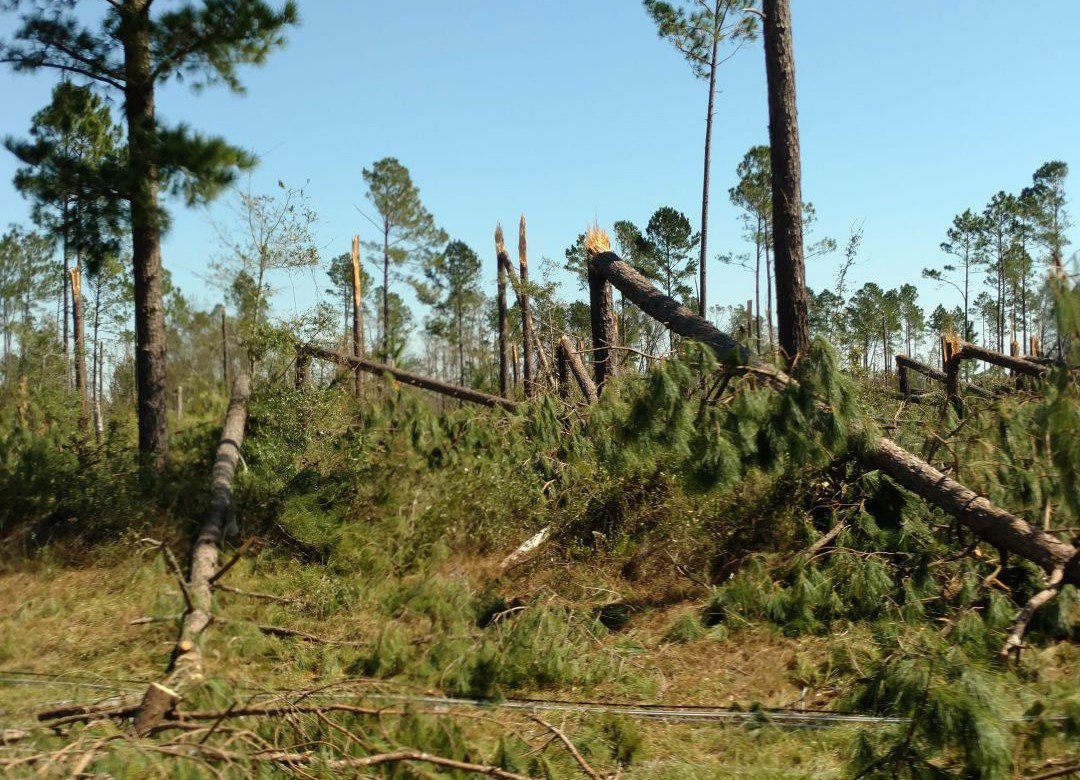
Florida’s foresters, land managers and storm recovery crews have more than just the obvious devastation left behind by Hurricane Michael.
Now, they must prepare for the potential of massive wildfires, floodplains flooding, and the prospect of devastation by pine beetles.
That was part of the sobering message given Tuesday to the Florida Senate Environment and Natural Resources Committee from the state’s forester and other state experts who outlined not just the human tragedy of Hurricane Michael’s Oct. 10 blitz through the Panhandle — 45 dead, untold numbers of human lives uprooted — but the ramifications of more than 2.8 million acres of felled or damaged forests: fuel for fires, clogged waterways, and food for waves of insect pestilence.
They also talked of a long, arduous, costly recovery that would never reach full recovery, and would require efforts beyond what state and federal experience and resources are prepared to define yet, let alone tackle fully.
Michael devastated the communities through the central Panhandle but also laid waste to some of the state’s broadest and densest forests, much of it privately owned by 16,000 private landowners. He said the losses just to forests are $1.29 billion in Florida, and more in Georgia. Other agriculture was stricken too, but current estimates of losses were in the tens of millions of dollars each for cattle, cotton, peanuts, nurseries, and aquaculture.
“The largest impact of forestry resources ever in the country by one, single, natural event, a really huge impact on us,” said Florida State Forester Jim Karels.
Committee Chair Bill Montford, the committee’s members and guest Sen. George Gainer, the Panama City Republican, all pledged to make recovery a top priority for the committee and the Senate. Gainer, who represents much of the most-severely impacted area, urged people to stop making comparisons between Michael and previous hurricanes’ recoveries.
“Irma would not make a freckle on the ear of Michael,” Gainer said of the 2017 hurricane. “It just tore up everything; 300-year-old trees just laying there, pulled up by the root … all over the place. Not dozens of them. Thousands. That’s the kind of destruction we’re talking about.”
The worst, Karels showed, was a 20-mile-wide swath through Bay and surrounding counties on into Georgia that was designated as “catastrophic,” in what he called “the heart of forestry in Florida, and really the heart of big-timber forestry in Florida.”
“About 350,000 acres was really wiped out. It was almost as if you took a massive Weed Eater and put it on the ground, into that pole timber,” Karels said.
Add to that about a million acres of “severe” damage, where 75 percent of the trees were down or broken, resembled jackstraw, he said. Another 1.5 million acres suffered “moderate” damage, he said.
In addition to the human side, the region’s agriculture, aquaculture, and forestry industries, as well as parks and tourism, not only face long and expensive recoveries. The region also faces severe threats of fire, flooding and beetle infestation because the estimated 50 million cubic yards of debris are fuel, are blocking creeks, and will be attracting the pine beetles and other pests that could ravage what’s left.
“More than 70 percent of the canopy has now become surface fuel for fires,” said David Clark, deputy secretary of land and recreation for the Florida Department of Environmental Protection.
Flooding is worse now than it was at the peak of Michael’s direct impact, and that involves whole floodplains areas with timber blockage in areas that are too often inaccessible. To illustrate, Brett Cyphers, executive director of the Northwest Florida Water Management district, showed slides of houses surrounded, which he described as now being parts of creeks.
“Nearly 1,200 miles of not just the Chipola River and various creeks,” Cyphers said. “There are trees down that don’t allow the water to move out.”
Many of the surviving trees are stressed. They and the debris fields are likely to attract all sorts of pestilence, including invasive species, likely led by the southern pine beetle, which girdles and kills trees and can take down whole forests.
“What the southern pine beetle comes to is it comes to stress,” Karels said. “Now we’ve got 3 million acres of pine timber that’s stressed, that’s either on the ground or standing stressed, and is an absolute breeding ground for this beetle infestation. That 1.5-million-acres of ‘moderate’ [destruction], we could lose that if we don’t stay on top of this … and we don’t know yet how it will impact us.”




2 comments
Patricia Beauchamp
January 10, 2019 at 7:50 pm
Thank you for this article! My home is in the path you described and the timber on the 59 acres around it and so much more I have seen in Jackson county ….
Articles such as yours will be helpful to those who try to make decisions about the future of our area.
Patricia
January 15, 2019 at 7:23 pm
Thank You for your honesty.
Comments are closed.